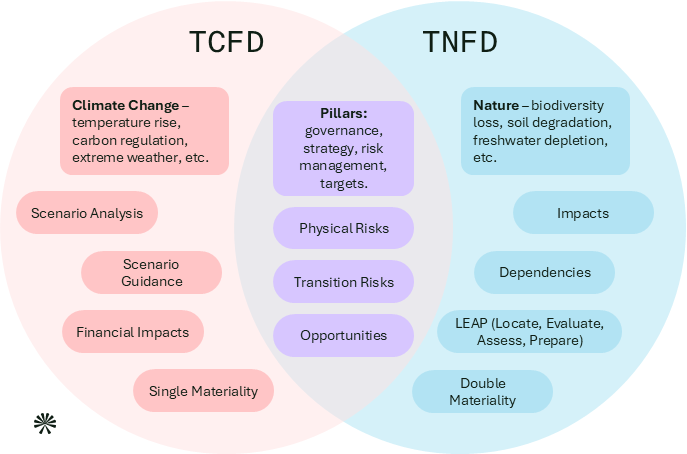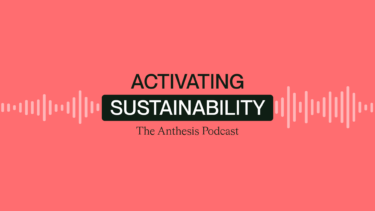
Table of Contents
Share this article
Climate and nature are inseparable, with intertwined impacts on business, society, and daily life. However, most companies still analyse and report on climate and nature separately, creating blind spots in corporate strategy and resulting in sourcing, investment, and land use decisions that are based on an incomplete picture of the risks involved. By integrating climate and nature risks, companies can instead leverage a more comprehensive foundation for resilience and can gain a competitive edge in an uncertain future.
From frameworks to foresight: Using TCFD and TNFD together
The consequences of a fragmented approach to climate and nature risks can be significant. Climate risks like extreme weather events and the transition to a low-carbon economy can accelerate biodiversity loss and ecosystem degradation. In turn, degraded ecosystems weaken natural defenses against physical risks like flooding or drought, amplifying sourcing and the supply chain disruptions for businesses dependent on critical commodities. When climate and nature risks compound each other, assessing them separately creates gaps and dangerously underestimates true exposure.
Integrated assessments of both climate and nature can work to close these gaps. The Task Force on Climate-related Financial Disclosures (TCFD) and the Taskforce on Nature-related Financial Disclosures (TNFD) are complementary frameworks for assessing and disclosing the financial impacts of climate-related and nature-related risks and opportunities, respectively.
TCFD helps organisations disclose the financial impacts of physical risks (extreme climate events) and transition risks (policy, technology, market, and reputation) from climate change, while TNFD addresses nature-related risks, including ecological dependencies and impacts, through tools like the LEAP (locate, evaluate, assess, prepare) approach. Importantly, TNFD highlights the ecosystem services businesses and their supply chains rely on to grow commodities or maintain continuity in their operations, like pollination, water regulation, soil fertility, and disease control, which are often missing in traditional climate risk models.
By integrating TCFD and TNFD, companies can go beyond compliance to strategic foresight, recognising how climate and nature changes interact and compound financial impacts across operations, supply chains, and markets.
Compounding climate and nature risks in action: Commodities
Climate risk assessments have become more common as financial reporting becomes mandatory, yet many companies still overlook the equally critical, and interlinked, nature-related risks. Deforestation, biodiversity loss, and water stress are not only nature issues – they amplify climate-related disruptions – and assessing climate and nature risks separately can create specific blind spots in sourcing, land use, and resource planning. Integrated assessments are therefore no longer a niche consideration, but a strategic imperative.
At Anthesis, we support clients in developing integrated assessments that holistically combine climate and nature risk analysis for reporting and planning, uncovering critical, interacting blind spots. Beyond operations, we also assess how climate change may affect commodity yield, pricing, and productivity across plausible futures.
For example, consider a multinational food and beverage company sourcing soy:
- A standalone climate assessment might show that the region faces future water stress from drought, flagging a moderate risk to supply.
- A regulatory review may flag new deforestation-free sourcing laws or disclosure requirements.
- A separate nature assessment might flag that same region for high rates of deforestation.
An integrated analysis reveals the critical insight these silos miss: deforestation (a nature risk) is eroding the ecosystem’s ability to retain water and regulate local climate. This amplifies the financial and operational impact of the projected climate-driven droughts (physical risk) and exposes the company to compliance and market-access risks from emerging deforestation-free laws (transition risk).
This compounding effect reveals a far greater threat of supply chain disruption and price volatility than either analysis would suggest alone. With integrated foresight, the company can shift from reactive risk management to proactive strategy, enabling smarter, more resilient sourcing and capital investment decisions.
The limits of current frameworks and the power of integration
Increasing water stress on soy crops is a physical climate risk, but its residual effects create nature risks: reducing water availability, crop yields, and biodiversity. These impacts disrupt supply chains, increase production costs, and threaten long-term resource security. Soy expansion is a major driver of deforestation, which destroys habitats, reduces pollinators, and weakens natural buffers against floods, landslides, and water stress. New regulations like the EU Deforestation Regulation add transition risks by limiting market access for soy linked to deforestation.
Viewed separately, these risks understate true exposure. And while TCFD and TNFD provide structured outlines to identify, assess, and disclose these risks, their true power lies in integration. Integrated risk assessments reveal how climate, nature, and policy pressures interact, enabling companies to anticipate systemic disruptions and make better sourcing, investment, and resilience decisions.
TNFD extends TCFD by focusing on the ecosystems and ecosystem services that businesses rely on to function: pollination, water regulation, soil fertility, and more. As an added benefit, aligning with both frameworks not only meets regulatory and investor expectations under CSRD, SB 261, and ISSB, but also helps companies build adaptive strategies in a world shaped by dual environmental crises and expanding disclosure mandates.
For example, in the food sector, soy expansion upstream drives deforestation and water stress, creating exposure for processors and traders. Downstream, consumer goods companies and retailers face reputational damage and market-access risks if deforestation-linked soy is embedded in their supply chains. Similarly, in the apparel sector, cotton production depends on water-intensive upstream processes, while brands downstream are vulnerable to both physical supply shocks and rising scrutiny over nature impacts.

Bringing the value chain into focus
While the TCFD and TNFD share structural similarities (governance, strategy, risk management, and metrics), there are important differences. Climate risk analysis benefits from decades of scientific modeling and standardised data, while nature risk evaluation in the corporate context is newer and less harmonised. TCFD, though foundational, is not sufficient on its own: it does not explicitly consider nature-related dependencies and impacts that may pose material financial risks across supply chains, operations, and valuation. For investors and businesses seeking resilience, long-term value creation, and regulatory alignment, especially under frameworks like the CSRD and the emerging ISSB–TNFD convergence, integrating climate and nature risk is not optional, but essential.
Importantly, value chain analysis is now a regulatory mandate, not just good practice, CSRD and ISSB both require companies to examine upstream and downstream dependencies and impacts. For sectors heavily reliant on commodities like soy, cocoa, or cotton, integrating ingredient risk screening is critical. Dual analysis is also required: understanding risks to the business (like drought affecting soil fertility and crop yields) and risks from the business (like deforestation and biodiversity loss driven by sourcing practices). Tools such as TNFD’s LEAP approach help structure this assessment, capturing both dependencies on nature and impacts to nature, and translating them into financial and strategic terms.
This raises important questions for companies: How does your business connect the dots between climate and nature? Full integration requires a deliberate effort to link nature dependencies (like healthy soil, pollinators, or water availability) with climate hazards (like drought or floods), and then to quantify how those compounded effects translate into operational and financial risk. This is the work that moves companies from compliance to resilience.
Businesses that proactively integrate climate (TCFD) and nature (TNFD) can:
- Address systemic risks: Recognising climate change and nature loss as systemic threats to the global financial system.
- Improve transparency: Enhancing disclosure of interconnected environmental risks and opportunities.
- Enable better decision-making: Providing investors and executives with data that drives smarter capital allocation.
- Drive sustainable outcomes: Catalysing the shift to a more sustainable, resilient economy.
- Anticipate disruptions: Identifying compounding risks and value chain vulnerabilities before they materialise.
- Build resilient strategies: Creating forward-looking plans grounded in a complete risk picture.
- Meet regulatory and investor expectations: Aligning with CSRD, ISSB, and other regimes increasingly requiring integrated climate-nature risk.
Both frameworks are critical to ensuring that financial markets properly value environmental risks and incentivise responsible corporate action. Businesses that proactively incorporate climate and nature into their risk management practices can better anticipate market shifts, address investor concerns, and unlock opportunities for sustainable innovation and natural resource preservation. By understanding the full spectrum of environmental risks and opportunities, companies can not only enhance resilience but also secure long-term competitive advantage.
From insight to action
As climate-related risks become more widely assessed, it’s increasingly clear that nature risks are deeply connected and often overlooked. Companies that treat them in isolation can have blind spots in strategy, especially as environmental disruptions compound across supply chains, assets, and markets. A unified approach that integrates climate and nature risks is no longer just a reporting requirement, but a strategic imperative. Businesses that proactively align with TCFD and TNFD can anticipate market shifts, meet investor expectations, and capitalise on opportunities for sustainable innovation – all while protecting the natural systems their operations depend on.
At Anthesis, we help companies move from insight to action through integrated climate and nature risk assessments tailored to their value chains. Our approach combines geospatial and financial analysis to identify location-specific exposure, quantify impacts under different scenarios, and prioritise strategic responses. Whether the goal is to meet regulatory requirements, safeguard continuity, or evaluate investment trade-offs, we provide the data, tools, and guidance to turn risks into resilience. By aligning with both TCFD and TNFD, we enable clients to future-proof operations and build competitive advantage in an increasingly risk-aware marketplace.
Explore our Climate & Nature Solutions
We offer tailored climate-nature risk solutions and conduct value chain risk analysis to turn emerging pressures into long-term opportunity.
We are the world’s leading purpose driven, digitally enabled, science-based activator. And always welcome inquiries and partnerships to drive positive change together.



